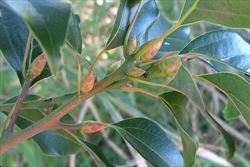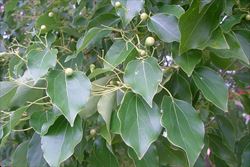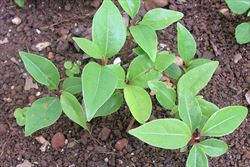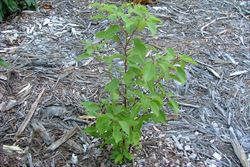Click on images to enlarge

infestation (Photo: Sheldon Navie)

habit (Photo: Sheldon Navie)

main trunks (Photo: Sheldon Navie)

young branch, leaves and leaf buds (Photo: Sheldon Navie)

close-up of leaf (Photo: Sheldon Navie)

clusters of flower buds (Photo: Sheldon Navie)

flowers (Photo: Sheldon Navie)

leaves and immature fruit (Photo: Sheldon Navie)

close-up of mature fruit (Photo: Sheldon Navie)

close-up of seeds (Photo: Steve Hurst at USDA PLANTS Database)

seedlings (Photo: Sheldon Navie)

root sucker (Photo: Sheldon Navie)
Scientific Name
Cinnamomum camphora (L.) Nees & Eberm.
Synonyms
Camphora camphora (L.) H. Karst.Camphora officinarum NeesCinnamomum camphoroides HayataCinnamomum officinalis Nees ex Steud.Cinnamomum officinarum Bauh.Laurus camphora L.Persea camphora (L.) Spreng.
Family
Lauraceae
Common Names
camphor laurel, camphor, camphor tree, camphortree, Formosa camphor, gum camphor, Japanese camphor, shiu leaf, true camphor
Origin
Native to eastern Asia (i.e. China, Taiwan, northern Vietnam and Japan).
Cultivation
Widely cultivated in Australia as a street and garden tree, particularly in sub-tropical and warmer temperate regions.
Naturalised Distribution
This species has a widespread naturalised distribution, mainly in the eastern parts of Australia. It is most common in the coastal areas of south-eastern Queensland and north-eastern New South Wales. Also naturalised in northern Queensland, in other parts of coastal New South Wales, in south-western Western Australia, in Victoria, and on Lord Howe Island and Norfolk Island.
Naturalised overseas in southern Europe, the Canary Islands, southern Africa, Madagascar, La Reunion, Hawaii and southern USA.
Habitat
A weed in neglected areas near habitation, on street verges, along roadsides, in native bushland, rainforests, moist open woodlands, pastures, and especially along waterways (i.e. in riparian areas).
Habit
A large and spreading tree, often growing 15-30 m tall.
Distinguishing Features
- a large spreading tree with light brown or greyish-brown bark that is scaly or fissured.
- its leaves have glossy green upper surfaces and duller undersides, and give off a distinctive camphor smell when crushed.
- its leaf buds are enclosed in distinctive overlapping scales when they are young.
- its tiny whitish-coloured flowers are borne in branched clusters at the tips of the branches and have six tiny 'petals'.
- its globular fruit (8-10 mm across) turn from green to glossy black as they mature and are attached to the stem by a distinctive cup-shaped structure.
Stems and Leaves
The rough bark is light brown or greyish-brown in colour, scaly or fissured, and has a strong odour (i.e. it is highly aromatic). Young branches are green or reddish-green in colour, rounded and hairless (i.e. glabrous).
The leaves are alternately arranged, but sometimes densely clustered (i.e. pseudo-whorled), with leaf stalks (i.e. petioles) 15-40 mm long. These leaves (4.5-11 cm long and 2.4-6 cm wide) vary from oval (i.e. elliptic) to broadly egg-shaped in outline (i.e. broadly ovate) and have three distinct veins spreading from their bases. Their upper surfaces are bright green and glossy, while their undersides are paler green and duller in nature. They are hairless (i.e. glabrous) with entire margins, that are often wavy (i.e. undulating), and have pointed tips (i.e. acute apices). The leaf buds are enclosed in distinctive overlapping scales when they are young. Oil glands and two small raised swellings (i.e. domatia) are evident on the undersides of the leaves, if they are observed with a hand lens.
Flowers and Fruit
The flowers are small with six whitish, greenish-white or pale yellowish 'petals' (i.e. perianth lobes) 1.5-3 mm long. They also have 5-9 stamens. These flowers are borne in small branched clusters (about 7.5 cm long) at the tips of the branches (i.e. in terminal panicles). Flowering occurs mostly during spring and summer, particularly in the middle of spring.
The fruit look like 'berries', but they are actually drupes containing a hard centre. These fruit are globular (8-10 mm across), glossy in appearance, and turn from green to black as they mature. They are attached to the stem by an enlarged, greenish-coloured, cone-shaped or cup-like structure (i.e. a conical or cupular receptacle) that is about 5 mm across. The fruit are present mostly during autumn and early winter (i.e. from April to June).
Reproduction and Dispersal
This plant reproduces by seed, which are most commonly spread by birds, but may also be dispersed by water, other animals, and in dumped garden waste. Suckers are also readily produced, particularly when older trees are poisoned, damaged or cut down.
Environmental Impact
Camphor laurel (Cinnamomum camphora) is a significant environmental weed in New South Wales and south-eastern Queensland, where it is actively managed by community groups. It is also regarded as a potential environmental weed or "sleeper weed" in northern Queensland and other states (e.g. Western Australia and Victoria). It is currently having the greatest impact in south-eastern Queensland, where it is ranked among the top 10 most invasive plants, and in north-eastern New South Wales (particularly in the Richmond-Tweed and Bellingen districts). During a recent survey, this species was also listed as a priority environmental weed in three Natural Resource Management regions. It is also a growing concern in the wider Sydney and Blue Mountains region in central New South Wales.
Camphor laurel (Cinnamomum camphora) is a large tree that aggressively invades moist gullies, open woodlands, rainforest margins, and vegetation near waterways (i.e. riparian areas). It creates a dense canopy, competes with and replaces native species, and continues to inhibit their regeneration even after it has been removed. Along the waterways of south-eastern Queensland it is replacing the native blue gums (Eucalyptus tereticornis), one of the favourite food trees of the koala.
It is also regarded as being invasive in other parts of the world, and has been listed in the Global Invasive Species Database.
Other Impacts
Camphor laurel (Cinnamomum camphora) also invades pastures and is a troublesome weed on dairy farms throughout south-east Queensland and northern New South Wales. It most frequently germinates under fences and powerlines, where birds tend to rest and deposit the seed. As it grows in these locations it can push over fences and disrupt power facilities. Mature camphor laurel (Cinnamomum camphora) trees develop a massive root system which are known to block drains and crack concrete pavements. The fruit, leaves, and roots are also toxic to humans if ingested in sufficient doses.
Legislation
This species is declared under legislation in the following states and territories:
- New South Wales: Class 4 - a locally controlled weed. The growth and spread of this species must be controlled according to the measures specified in a management plan published by the local control authority and the plant may not be sold, propagated or knowingly distributed (in the Ballina, Bellingen, Blue Mountains, Byron, Clarence Valley, Hornsby, Ku-ring-gai, Kyogle, Lismore, Nambucca, Richmond Valley, Ryde, Tweed and Willoughby local authority areas).
- Queensland: Class 3 - this species is primarily an environmental weed and a pest control notice may be issued for land that is, or is adjacent to, an environmentally significant area (throughout the entire state). It is also illegal to sell a declared plant or its seed in this state.
- Western Australia: Unassessed - this species is declared in other states or territories and is prohibited (throughout the entire state) until assessed via a weed risk assessment.
Management
For information on the management of this species see the following resources:
- the Biosecurity Queensland Fact Sheet on this species, which is available online at http://www.dpi.qld.gov.au.
Similar Species
There are several closely related native species which can be confused with camphor laurel (Cinnamomum camphora). However, most of these can be separated by the fact that they do not give off a strong camphor smell when their leaves are crushed. Oliver's sassafras (Cinnamomum oliveri) does have a strong camphor smell, however its leaves are oppositely arranged, or nearly so, and they are narrower than the leaves of camphor laurel (Cinnamomum camphora)

